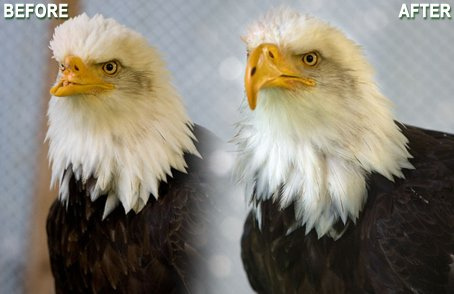
3D printed prosthetic beak created for the bald eagle named Beauty. Courtesy of Birds of Prey Northwest.
Latest News
September 13, 2012
In the course of my diligent efforts to keep you good people up to date on the state of additive manufacturing, I come across many interesting news items. I’ll gather them up every so often and present them in a Rapid Ready Roundup (like this one). You can find the last Roundup here.
We’ll start this Roundup with a look at another sign of the growth of additive manufacturing (AM). 3D Systems (company profile) has appeared on Fortune Magazine’s 2012 list of the fastest growing companies, placing 5th among tech companies.
“We are honored to have made this prestigious list along with some of the largest and most celebrated companies in the world. It has been a true team effort by 3D Systems employees, partners and supporters to deliver the results that earned this esteemed recognition,” said Abe Reichental, president and CEO of 3D Systems.
Next, engineering students from the University of Washington placed second in the annual Milk Carton Derby. Race contestants build boats using milk cartons as the primary floatation device. UW students took that idea a step further and used recycled milk cartons and a “hacked” plasma cutter rewired to act as a 3D printer to construct their boat.
“Frankly, milk jug material is an awful material to work with,” said faculty adviser Mark Ganter, professor of mechanical engineering. “It shrinks, it curls, it doesn’t want to stick to itself. Overcoming all those parts of the problem was part of the achievement.”
Even when people aren’t using recycled milk cartons, advances in AM materials are always worth a look. EnvisionTEC has announced the release of two new AB resin materials at IMTS 2012. According to the company, the new materials – ABflex and ABStuff – allow for quicker production of quality ABS products while keeping costs low.
“Today EnvisionTEC again changed our industry by announcing the release of our new AB resins that have the true replication DNA of production grade ABS. Our new AB material offers long-term UV stability, is fully functional and does not lose any physical characteristics or incur material creep or degradation over time,” said Al Siblani, CEO at EnvisionTEC.
Last, we offer the story of Beauty the bald eagle. In 2005, Beauty was shot in head by a poacher. Although the attack failed to kill her, the damage done to Beauty’s beak was serious enough she couldn’t manage to feed herself. Volunteers at Birds of Prey Northwest fed the injured bald eagle and returned it to health, but feared Beauty would never again be able to eat without aid, likely leading to her being euthanized.
Refusing to give up on the bird, raptor specialist Jane Fink Cantwell worked with a mechanical engineer, a dentist and a variety of other scientists to design a prosthetic beak that would give Beauty the ability to feed herself. The prosthetic was designed using CAD software and built by a 3D printer. The new beak has made Beauty more self-sufficient, but not to the point where she could live in the wild without assistance. Cantwell hopes that the work can lead to further improvements and lend aid to other animals in the future.
Below you’ll find a video about Beauty.
Sources: 3D Systems, Robotics Tomorrow, University of Washington, Grist
Subscribe to our FREE magazine, FREE email newsletters or both!
Latest News
About the Author
John NewmanJohn Newman is a Digital Engineering contributor who focuses on 3D printing. Contact him via [email protected] and read his posts on Rapid Ready Technology.
Follow DE







